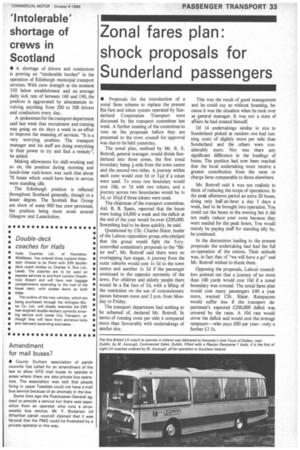Zonal fares plan: shock proposals for Sunderland passengers
Page 35

If you've noticed an error in this article please click here to report it so we can fix it.
• Proposals for the introduction of a zonal fares scheme to replace the present flat-fare and token system operated by Sunderland Corporation Transport were discussed by the transport committee last week. A further meeting of the committee to vote on the proposals before they are presented to the town council for approval was due to be held yesterday.
The zonal plan, outlined by Mr. R. E. Bottrell, general manager, would divide Sunderland into three zones, the first zonal boundary being +-mile from the town centre and the second two miles. A journey within each zone would cost 5d or 3-1-d if a token were used. To cross one boundary would cost 10d, or 7d with two tokens, and a journey across two boundaries would be is 3d, or 10+d if three tokens were used.
The chairman of the transport committee, Ald. R. B. Spain, reported that the buses were losing £4,000 a week and the deficit at the end of the year would be over £200,000. Something had to be done quickly, he said.
Questioned by Cllr. Charles Slater, leader of the Labour opposition group,who pledged that the group would fight the Torycontrolled committee's proposals to the "Bitter end", Mr. Bottrell said there were no overlapping fare stages. A journey from the outer suburbs would cost Is 3d to the town centre and another Is 3d if the passenger continued to the opposite extremity of the town. For children and elderly people there would be a flat fare of 3d, with a lifting of the restriction on the use of concessionary passes between noon and 2 p.m. from Monday to Friday.
The transport department had nothing to be ashamed of, declared Mr. Bottrell. In terms of running costs per mile it compared more than favourably with undertakings of similar size. This was the result of good management and he could say so without boasting, because it was the situation when he took over as general manager. It was not a state of affairs he had created himself.
Of 14 undertakings similar in size to Sunderland picked at random one had running costs of slightly more per mile than Sunderland and the others were considerably more. Nor was there any significant difference in the loadings of buses. The position had now been reached that the local undertaking must receive a greater contribution from the rates or charge fares comparable to those elsewhere.
Mr. Bowen said it was not realistic to think of reducing the scope of operations. In the peak afternoon period an extra 20 buses, doing only half-an-hour a day 5 days a week, had to be brought into operation. You could cut the buses in the evening but it did not really reduce your costs because they were needed for the peak hours. You would merely be paying staff for standing idly by, he continued.
In the discussions leading to the present proposals the undertaking had had the full co-operation of the unions. Their attitude was, in fact that of "we will have a go" and Mr. Bottrell wished to thank them.
Opposing the proposals, Labour councillors pointed out that a journey of no more than 100 yards would cost 10d if a zonal boundary was crossed. The zonal fares plan would cost many passengers £40 a year more, warned Cllr. Slater. Ratepayers would suffer less if the transport department's expected £200,000 deficit was covered by the rates. A 10d rate would cover the deficit and would cost the average ratepayer—who pays £80 per year—only a further £3 5s.












































































































